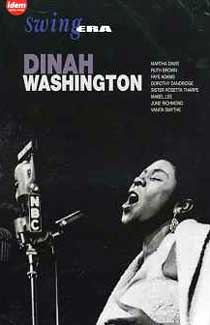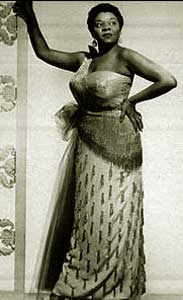 In 1955, thirteen episodes of Showtime at the Apollo aired on television, & were much later available on video tape. It is important to note that none of the material in these episodes was filmed at the Apollo Theater though to this day compilations are issued on dvd claiming otherwise.
In 1955, thirteen episodes of Showtime at the Apollo aired on television, & were much later available on video tape. It is important to note that none of the material in these episodes was filmed at the Apollo Theater though to this day compilations are issued on dvd claiming otherwise.
These half-hour "concerts" were actually stitched together from Snader telescriptions filmed in 1951 with new material filmed in Manhattan by Studio Telescriptions in 1954. Some were released as television filler as separate three-minute films, other of these short-short films were only released as part of the faked-Apollo-concerts.
The new material tended to be the commedians doing shtick & host Willie Bryant appearing in front of a curtain pretending to be introducing musical acts which were actually already filmed in 1951-1954.
Like the soundies issued 1941-1947, the telescriptions from 1951-1954 were precursors to modern music videos. The soundies were lipsynch performances but still unique to the soundies because the sound would be recorded the day before then acted out for camera soon after.
But the telescriptions were legitimate live performances & though rarely as elaborately staged as were many of the soundies, the fact that they's not lipsynched is in their favor. In some cases these tiny films are the best surviving representations of recording artists' live acts.
Originally the telescriptions were designed to be played on early television by a "disc jockey" the same as on a radio station but requiring the acts to be seen since it was television. The prediction that television would be a lot like radio, however, turned out to be inaccurate, & very few stations used the telescriptions in disc jockey formats, preferring them for filler whenever there was time left over before the hour or half-hour & too few advertisements placed for the time.
So Louis D. Snader's company went belly-up by 1953 & his large backlist was bought up by Studio, who added to the catalog in 1953 & 1954 then gave it up when leasing them to television stations just wasn't working out. These weren't only black artists of course, but there were a great many black artists.
So in 1954 Studio pulled all the older Snaders into a separate category, filmed a great many more telescriptions with black artists including comics who were in Manhattan that year, & then stitched them together into the thirteen "concert" programs the content of which greatly overlapped two feature-length releases of the same material for theatrical showings.
Sometimes it's hard to date the individual mini-films. as many, like those featuring Cab Calloway or Count Basie date to 1951 from Snader, while other acts, such as The Larks, were booked around Harlem in 1954 & came to the Studio studio to make a set of telescriptions all in one day.
Records of which were done when are incomplete, & sometimes Studio released Snaders as three-minute films with their own title card replacing the original Snader card, so even if a given film says Studio Telescription that was sometimes only because they bought up the older films.
But whenever you see the Paul Williams band backing up singers, those were not Snader telescriptions; they were Studio telescriptions, from 1954. This included the Dinah Washington telescriptions.
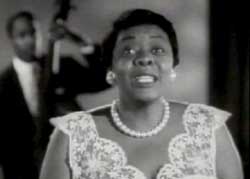 Only a Moment Ago (1954) was spliced into Showtime at the Apollo: Revue in Rhythm (1955) & was also included in the theatrical feature-length release The Rock 'n' Roll Review (1955). The half-hour television program also featured Snader telescriptions, two by Duke Ellington, one by Nat "King" Cole; & a Studio telescription with Larry Darnell.
Only a Moment Ago (1954) was spliced into Showtime at the Apollo: Revue in Rhythm (1955) & was also included in the theatrical feature-length release The Rock 'n' Roll Review (1955). The half-hour television program also featured Snader telescriptions, two by Duke Ellington, one by Nat "King" Cole; & a Studio telescription with Larry Darnell.
Dinah sings Only a Moment Ago with such swing-jazz perfection. It is a beautiful song rendered more beautiful by her interpretation.
The Paul Williams orchestra is seated in the background, but in the main keeps quiet, so you can hear only a simple line of piano accompaniment. Someone clearly recognized that Dinah's voice needs nothing fancy added to be as good as singing gets, & you'll never see her any better than in this short-short film.
Some have faulted the Studio telescriptions vs. the original Snaders for being more cheaply done. But the Snaders, too, were all done hastily, & these Studios have good sound to really represent artists fairly.
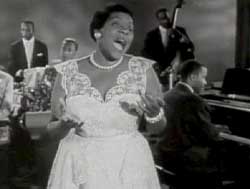 For Such a Night (1954) we see the exact same stage arrangement as for Only a Moment Ago. Dinah's even wearing the same gown. This telescription got spliced into Showtime at the Apollo: Blues in Harlem (1955).
For Such a Night (1954) we see the exact same stage arrangement as for Only a Moment Ago. Dinah's even wearing the same gown. This telescription got spliced into Showtime at the Apollo: Blues in Harlem (1955).
This episode also incorporated Snader films of Duke Ellington (Mood Indigo, & Sophisticated Lady, 1952) & Herb Jeffries (Baby Won't You Please Come Home, 1950), with Studio films of Amos Milburn (Down the Road A Piece, 1954), Larry Darnell (Don't Go, 1954), the Clovers (Miss Fanny, 1954), & comedian Nipsy Russell, made to look like a single concert night by the addition of series host Willie Bryant.
Dinah sings this one as more of a jump-jazz number than a swing tune. As such, it might've done with a sax or trumpet, but again somebody wanted Dinah's tremendous voice to be pretty much the only thing recorded.
So the band is again sitting in the background but scarsely seem to be performing, except for the pianist. Although, if you listen closely, you will hear a faint slap-bass & a bit of high-hat & brushes on a snare.
She puts some pop-verve into her voice that all but trill, so that it's not the equal of Only a Moment Ago which required no vocal tricks to transcend. But that's an "all things relative" comparison, for compared to anyone but herself being even better, this is great.
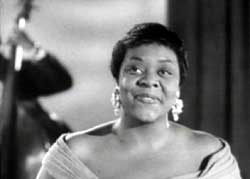 Before filming I Don't Hurt Anymore (1954), she took a break & changed gowns, but Paul William's sextet got back in identical positions as if no time had passed.
Before filming I Don't Hurt Anymore (1954), she took a break & changed gowns, but Paul William's sextet got back in identical positions as if no time had passed.
This number got spliced into Showtime at the Apollo: Rhythm in Harlem (1955), an episode that also featured Herb Jeffreys (When I Write My Song, 1950), Lionell Hampton (Cobb's Idea, (1951), Larry Darnell (Be Good to Me, 1954), Ruth Brown (Oh What a Dream, 1954), & the Clovers (Da De Day, 1954). Plus there is spliced in Bill Bailey tapdancing, & Willie Bryant posing as master of ceremonies tying it altogether as a one-evening's faux live concer.
This time for Dinah there are two saxophones in the background (Paul Williams on baritone sax) playing quietly; they & the entire sextet is subdued. So for a third time hear mainly Dinah's voice.
Although this was filmed the same day as the others, Dinah's even prettier by gum, & I think it's that sweet sextet & the jump-blues arrangement that's making her sparkle with joyousness.
This Ella Fitzgerald or Sarah Vaughn style of jazz singings isn't often my fave even when it's great, but Dinah is beyond great, perhaps the best that ever was for this beside-the-piano swing-jazz vocal art. She's still powerfully in her prime for these telescriptions, though she'd soon be making herself very sick from drug abuse.
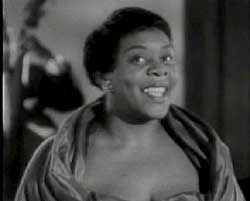 Dinah changes gowns again for My Lean Baby (1954), her fourth & final telescriptions. Though these films are b/w, I somehow imagine this shimmering dress as emerald.
Dinah changes gowns again for My Lean Baby (1954), her fourth & final telescriptions. Though these films are b/w, I somehow imagine this shimmering dress as emerald.
The musicians in the Paul Williams sextet are also in different suits, but it's not likely it's even so much as a day later. The oddest thing is the orchestra's bandstand seats have been swapped for bigger ones with "PW" emblazoned on the front, as though it belatedly dawned on someone that the band deserved a visual identifier.
Paul "Hucklebuck" Williams had had a big hit in 1949 with his recording of "The Hucklebuck." He plays baritone saxophone & leads his band, & led the houseband for Atlantic Records. He retired by the '60s, but in the '80s was back & made two new albums.
He was awfully talented, & his band is one of the reasons the faked "concerts" work. He not only provides some continuity for what might otherwise seem a hodgepodge of featurettes, but he backs some of the best singers without once getting it wrong.
For Dinah his orchestra is not hugely in evidence on the soundtrack but I do not believe this is the fault of Studio miking everyone correctly. When his guys needed to be loud, they were. The softness and/or minimalism of the instrumentation for her telescriptions was an artistic judgement call that works, rendering these among the purest recordings of her voice.
So for My Lean Baby as for all the Studio telescriptions the arrangement is minimalist to highlight her voice. This is jump-jazz, however, rather than pure swing, & jump-jazz can always do with a good Louis Jordan style sax or something eqivalent.
So it kind of smarts that you can see instruments in the background not being used. Only the drum, bass, & piano are heard, & even they're subdued. Luckily, though it's over halfway through the number, Paul's sax eventually joins in, however quietly with no instrumental solos.
Given that Dinah's a large woman, it's all the more fun to hear her singing of her man as: "He's slender but tender/ Makes my heart surrender/ And every night when I hold him tight/ Feels so nice my arms can go around twice/ He's so slim, a broomstick's wider compared to him/ But when he kisses me, then I know/ I love him so, I'll never never ever let him go."
She knows the song is sexy & comical & she has humor in her eyes, but also a profound dignity to her happiness, no outright mugging or merely comedic, because where Dinah's concerned, the voice is all she needs to keep an audience riveted. (And I do sometimes think it's too bad great performers like Satchmo felt it so essential to mug at the audience.)
From Dinah's lips, My Lean Baby is just a good song despite the jokiness of the lyrics, which is something that can be said of a lot of high-end jump-jazz, it knew how to laugh but it didn't stop having a great sound. It was spliced into the televised Showtime at the Apollo: Downbeat Revue (1955) together with Snader & Studio telescriptions by Count Basie, The Clovers, Amos Milburn, Nat King Cole, & the dancing Three Businessmen of Rhythm.
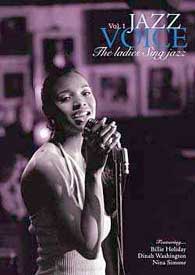 All four of these telescriptions can be seen together on Swing Era: Dinah Washington (2004) which also gets listed as Dinah Washington & Friends; or, Dinah Washington: Swing Era.
All four of these telescriptions can be seen together on Swing Era: Dinah Washington (2004) which also gets listed as Dinah Washington & Friends; or, Dinah Washington: Swing Era.
As these would not be near enough to justify a CD, there are many other women vocalists represented, a mix of telescriptions (Martha Davis, & Ruth Brown, & others) such as were used in the faux-Apollo concert series, & earlier soundies (Dorothy Dandridge, Vanita Smythe, June Richmond, Mabel Lee).
These sorts of short-short films get recycled in numerous compilations, besides being "quoted" in jazz documentaries. I've made no attempt to track them all, but they include a six-volume series The Archive (2006) which has Dinah in the third volume; & The Ladies Sing the Blues (1988).
Only a Moment Ago, I Don't Hurt Anymore & My Lean Baby can additionally be found on the dvd Jazz Voice: Ladies Sing Jazz Volume I (2006), together with performances by Nina Simone & Billie Holiday.
Two additional items by Dinah are included in this latter compilation, clips from unidentified television appearances, probably from 1958. These are "Send Me to the Electric Chair" which she recorded on her tribute album to Bessie Smith in 1958, & "Lover Come Back To Me" which she had recorded on her 1954 album Dinah Jams.
copyright © by Paghat the Ratgirl
|
